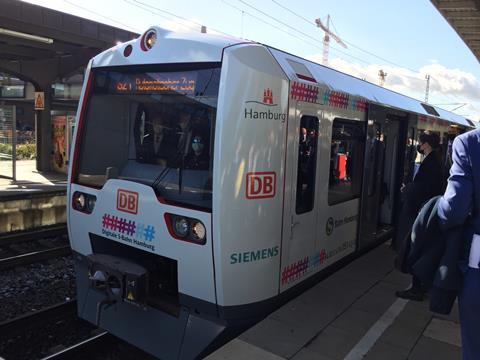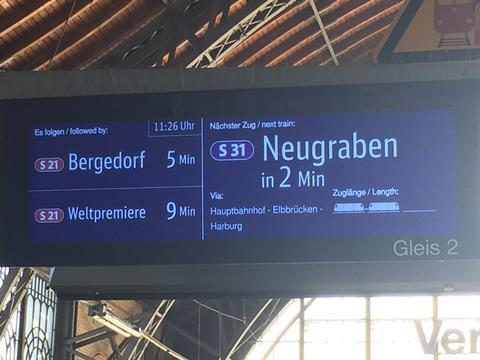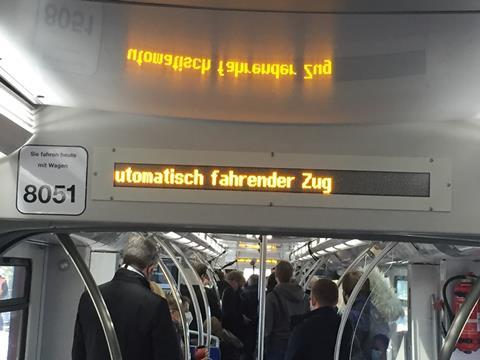
GERMANY: Deutsche Bahn and Siemens Mobility unveiled the first S-Bahn train in Hamburg equipped for automatic train operation at the city’s Dammtor station on October 11.
Under the Digital S-Bahn Hamburg programme, bringing together the city government, DB and Siemens Mobility, the 23 km eastern section of route S21 between Berliner Tor and Aumühle has been equipped with ETCS Level 2, controlled from an existing electronic interlocking and a new radio block centre at Bergedorf. Four of the Bombardier-built Class 474 EMUs have been fitted with ATO over ETCS enabling attended operation to Grade of Automation 2. The ATO equipment is mounted in a container under the trains to save space and minimise retrofitting work.
Under a related initiative involving Alstom, Nokia and Vodafone, the turnback at Bergedorf has been equipped with a 5G based control system allowing fully-automated reversing to GoA4.
Demonstrating progress with the ‘world premier’ project ahead of the Intelligent Transport Systems congress in Hamburg, DB Chairman & CEO Dr Richard Lutz, Siemens AG President & CEO Roland Busch and Hamburg Mayor Peter Tschenstcher joined guests at Dammtor for a trial run to Bergedorf. Busch noted that it was little more than three years since the co-operation agreement for the €60m pilot project was signed in July 2018, and the partners now had a service-ready technology. The four trains are expected to start using ATO in revenue operation with effect from the December timetable change.

Joining the driver in the cab of the test train, the mayor pressed the button to initiate ATO between Berliner Tor and Rothenburgsort. Based on the ETCS movement authorities and line profile, the system calculated an optimum driving and braking profile for each run between stations. Automatic opening and closing of the train doors was also demonstrated at Mittlere Landweg station.
On arrival at Bergedorf, the driver put the train into fully automatic mode, allowing the local control centre to send it into the stabling yard and reverse it back to the station.
According to Siemens project manager Boris Dickgiesser, the amount of data exchanged between train and track during the automatic reversing does not really require the full transmission capabilities of the 5G communications link. However, DB is keen to explore the benefits of using the system for future applications. DB project leader Jan Schröder added that the ETCS capability could in future allow quasi-moving block operation, potentially increasing line capacity by up to 30%.

Schröder emphasised that the ATO over ETCS application was suitable for mixed traffic operation, using ‘open interfaces based on European standards’. This would allow the technology to be deployed on anything from an S-Bahn train to an ICE high speed trainset, ‘independently of train type and line conditions’. He believed that this would make it ‘a major boost to all rail traffic and significant contributor to the mobility transition’.
During the ITS event, DB and Siemens plan to run two demonstration trains per day between Dammtor and Bergedorf, showing conference delegates and potential customers both the ATO and the Ideenzug concepts for next-generation regional trains.

Siemens Mobility CEO Michael Peter told Railway Gazette International that the ATO equipment had been fully certified by the Eisenbahn Bundesamt federal railway office and ‘could be rolled out tomorrow’ for any railway which has ETCS. ‘The use of standardised interfaces and fitting trains from a different manufacturer had demonstrated the full compatibility of the technology’, he said, suggesting that it would ‘offer a major step forward in energy efficiency, performance and quality of service.’



